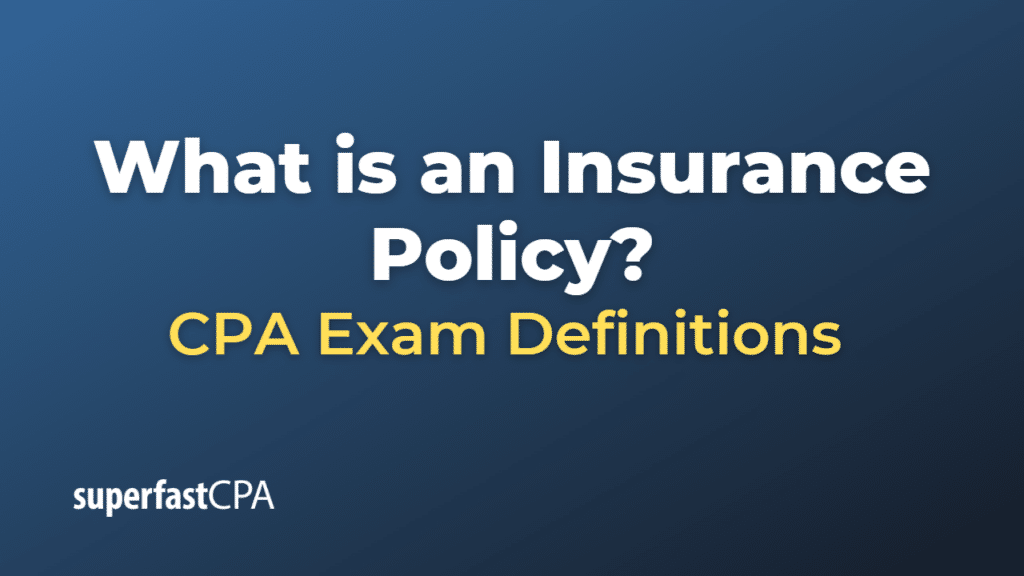Insurance Policy
An insurance policy is a contract between an insurance company (insurer) and an individual or entity (insured or policyholder). In this contract, the insurer agrees to pay the insured for specific potential future losses or damages that may occur in exchange for regular premium payments from the insured.
An insurance policy is designed to provide coverage for specific types of risks or events, and the terms of the policy outline what types of losses are covered, how claims are to be reported and settled, and how much coverage is available. The policy also includes details about the cost of the insurance (the premium) and any deductibles, which are amounts the insured must pay out-of-pocket before the insurance coverage kicks in.
There are various types of insurance policies, including:
- Health Insurance Policies: These provide coverage for medical expenses. They might cover doctor visits, hospital stays, medications, and other healthcare costs.
- Life Insurance Policies: These provide a payout to a designated beneficiary upon the death of the insured person. The funds can be used for any purpose, such as covering living expenses, paying off debts, or covering funeral costs.
- Auto Insurance Policies: These cover costs related to car accidents, theft, and other vehicle-related incidents. They might include liability coverage for injuries or property damage caused by the insured driver, as well as coverage for the insured vehicle’s repair or replacement costs.
- Homeowners Insurance Policies: These cover damage to a person’s home and belongings due to causes like fire, theft, or natural disasters. They also typically include liability coverage for injuries that occur on the property.
- Business Insurance Policies: These provide coverage for various risks businesses face, such as property damage, legal liabilities, and employee-related risks.
When purchasing an insurance policy, it’s important to carefully review the policy terms and conditions to understand what is covered, what isn’t covered, and what the policyholder’s obligations are. It can also be helpful to consult with an insurance agent or broker to find a policy that meets the specific needs of the individual or business.
Example of an Insurance Policy
Let’s take an example of a Homeowner’s Insurance Policy.
Imagine that John owns a house and decides to buy a homeowner’s insurance policy to protect his property. He contacts an insurance company and discusses his needs with an insurance agent. They decide on a policy that provides the following:
- Dwelling Coverage: This covers damage to the physical structure of John’s home. If a covered event like a fire or a hailstorm damages his house, the insurance company will pay for repairs up to the policy limit. The limit is set at $200,000.
- Personal Property Coverage: This covers John’s belongings inside the house, such as furniture, electronics, and clothing. If his belongings are stolen or damaged in a covered event, the insurance company will reimburse him for the loss, up to the policy limit. The limit for personal property coverage is set at $100,000.
- Liability Coverage: This provides protection if someone gets injured on John’s property and decides to sue. The insurance company would cover the legal expenses and any damages John is found liable for, up to the policy limit. The limit for liability coverage is set at $300,000.
- Additional Living Expenses (ALE) Coverage: If John’s house is severely damaged in a covered event and he needs to live elsewhere during repairs, this coverage will pay for his additional living expenses, such as hotel bills, restaurant meals, and other costs.
John agrees to pay an annual premium of $1,200 for this policy. He also has a $1,000 deductible, which means he’ll need to pay the first $1,000 of any loss out of pocket before his insurance coverage kicks in.
A few months later, a severe storm causes a tree to fall on John’s house, causing significant damage. John files a claim with his insurance company. After inspecting the damage, the insurance company agrees to pay for the repairs, minus John’s $1,000 deductible.
This example illustrates how an insurance policy works. It’s important to note that the specifics of a policy can vary greatly depending on the type of insurance, the insurance company, and the individual needs of the policyholder. It’s always a good idea to thoroughly review a policy and consult with an insurance professional if needed.













